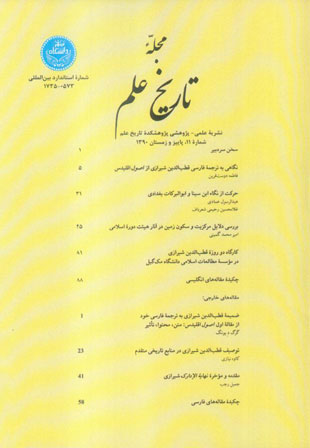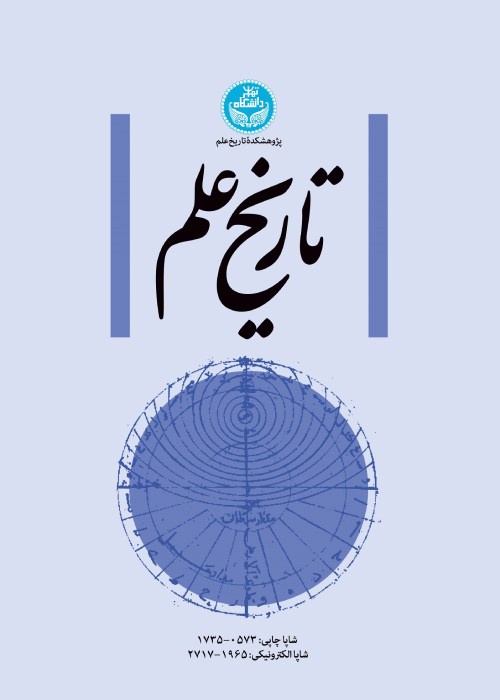فهرست مطالب

مجله تاریخ علم
سال نهم شماره 2 (پیاپی 11، پاییز و زمستان 1390)
- تاریخ انتشار: 1391/06/10
- تعداد عناوین: 8
-
-
سخن سردبیرصفحه 1
-
صفحه 5کتاب اصول اقلیدس، که گاهی آن را به نام مولفش «کتاب اقلیدس» نیز می نامند و در تالیفات ریاضی دوره اسلامی آن را به علت شهرت فراوانش کتاب اصول نیز خوانده اند، از منابع مهم ریاضیات دوره اسلامی بوده است. در این مقاله، پس از بررسی تاریخ ترجمه این اثر به زبان عربی و تحریر خواجه نصیرالدین طوسی از آن، برخی از ویژگی های این تحریر، از راه مقایسه آن با ترجمه اسحاق بن حنین، خواهد آمد. سپس با مقایسه بخش هایی از فن اول از جمله چهارم دره التاج قطب الدین شیرازی با ترجمه عربی اسحاق بن حنین و تحریر خواجه نصیرالدین طوسی، نشان داده می شود که اثر قطب الدین در واقع ترجمه فارسی تحریر اصول طوسی است، هرچند برخی تفاوت ها میان این دو اثر وجود دارد. در بخش پایانی مقاله یکی از این تفاوت ها بررسی می شود و آن شکلی واحد است که قطب الدین از تلفیق شکل های چهل و هشت قضیه مقاله اول اصول اقلیدس، ترسیم کرده است.
کلیدواژگان: اصول اقلیدس، قطب الدین شیرازی، تحریر اقلیدس خواجه نصیر، ترجمه اقلیدس اسحاق بن حنین، ترجمه اصول، کتاب اصول، ریاضیات دوره اسلامی -
صفحه 35هرچند ابوالبرکات مکان و زمان را شروط مقدم بر حرکت و زمان را نه مقدار حرکت که مقدار وجود می داند، با این حال معتقد است که می توان حرکت را بر حسب مفهومی شهودی از زمان، که غیر از مفهوم نظری زمان است، تعریف کرد و به این وسیله دوری را که در تعریف ارسطو از حرکت وجود دارد که خروج تدریجی (و در نتیجه، زمانی) از قوه به فعل است، حل می کند. در بحث از وجود یا عدم حرکت که ابن سینا با تقسیم حرکت به قطعیه و توسطیه برای نوع دوم وجود عینی و برای اولی وجود ذهنی قائل است، ابوالبرکات معتقد است حرکت نمی تواند مطلقا عدمی باشد، حتی اگر دارای وجودی لحظه ای و ناپایدار باشد. در بحث از علت حرکت ابوالبرکات با دیدگاه های ابن سینا موافق است که محرک غیر از متحرک است. همچنین در این مقاله دیدگاه های ابن سینا و ابوالبرکات درباره وحدت حرکت و تضاد و تقابل میان حرکات بررسی می شود.
کلیدواژگان: ابن سینا، ابوالبرکات بغدادی، حرکت، محرک، متحرک -
صفحه 51دلایل مرکزیت و سکون زمین را، در میان آثار نجومی دوره اسلامی، باید در کتب هیئت یافت. زیرا در این آثار، به کی هان شناسی ریاضی بر اساس هیئت مجسم افلاک و موقعیت زمین در میان آنها پرداخته شده است. این دلایل که در کتاب مجسطی بطلمیوس ریشه دارند، بر مشاهدات و پیش فرض هایی بنا شده اند. در این مقاله تک تک این دلایل مطرح و شرح داده می شوند و با روشی تحلیلی سعی می شود که پیش فرض های این دلایل روشن شوند. این تحلیل دو پیش فرض حرکت شناختی را نشان می دهد: 1) اگر متحرک از محرک جدا شود، دیگر به حرکت خود ادامه نخواهد داد؛ و 2) سرعت سقوط اجسام متناسب با وزنشان است.
کلیدواژگان: مرکزیت زمین، سکون زمین، حرکت وضعی، حرکت انتقالی، بیرونی، بطلمیوس، مویدالدین عرضی، نصیرالدین طوسی، قطب الدین شیرازی -
کارگاه دو روزه قطب الدین شیرازی در موسسه مطالعات اسلامی دانشگاه مک گیلصفحه 91
-
صفحات 1-21بخش نخست مقاله به ترجمه فارسی قطب الدین شیرازی از تحریر اصول اقلیدس، نوشته نصیرالدین طوسی اختصاص دارد و در آن به ضمیمه ای که شیرازی به متن افزوده توجه بیشتری شده است. ترجمه شیرازی به عنوان بخشی از اثر بزرگ دائرهالمعارف گونه او در سده های بعد بسیار مورد توجه قرار گرفته و خوانده شده است. نمونه ای از تاثیر ضمیمه شیرازی بر مقاله نخست را می توان در شرحی که محمد برکت در قرن نوزدهم بر رساله طوسی نوشته است، دید. من درباره این تاثیر اثر شیرازی در دوره متاخر در بخش دوم مقاله سخن خواهم گفت.
کلیدواژگان: قطب الدین شیرازی، محمد برکت، نصیرالدین طوسی، درهالتاج -
صفحه 25قطب الدین شیرازی (634-710ق) که زندگی علمی خود را به عنوان یک پزشک جوان آغاز کرد، ناگزیر شد در جستجوی دانش سفرهای دورودرازی بکند. وی که مقامش در علم شناخته شده و از ستایش و حمایت شخصیت های بزرگ زمان خود برخوردار بود، حتی در دورانی که در روم منصب قضا داشت و یا از سوی حامیان ایلخانی خود به سفارت می رفت، به فعالیت های علمی خود ادامه می داد. این مقاله با بررسی برخی از کتاب های تاریخی کهن می کوشد تا زندگی و سفرهای این متفکر بزرگ را روشن تر کند.
کلیدواژگان: قطب الدین شیرازی، التحفه السعدیه، ابن فوطی، ذهبی، سلامی -
صفحه 45قطب الدین شیرازی (634-710ق) چهار کتاب مهم در نجوم نوشته است: نهایه الإدراک فی درایه الافلاک، به عربی، که نخستین تحریر آن در اواسط شعبان 680ق به پایان رسیده است؛ اختیارات مظفری، به فارسی، که به مظفرالدین ارسلان حاکم قسطمونی در ترکیه کنونی تقدیم شده و تاریخ تالیف آن بین سال های 680 تا 684ق است؛ التحفه الشاهیه، به عربی، که به وزیر امیرشاه بن تاج الدین معتز بن طاهر در سیواس تقدیم شده و تاریخ تحریر آن اواخر جمادی الاول 684ق است؛ و فعلت فلا تلم، که شرحی است بر التذکره فی علم الهیئه نصیرالدین طوسی. این اثر پس از تحفه تالیف شده، که بنا به ادعای شیرازی در فعلت فلا تلم، شخصی به نام حماذی مطالب آن را انتحال کرده بود و از این رو شیرازی در این اثر گزنده به او پاسخ گفته است. هیچ یک از این آثار ویرایش یا ترجمه نشده است، و این امر، با توجه به اهمیت این آثار در شناخت نجوم دوران اسلامی، مایه شگفتی است. در این مقاله مقدمه و خاتمه نهایه الإدراک ویرایش و به انگلیسی ترجمه شده است، تا شاید گام کوچکی باشد در راه ویرایش آثار شیرازی.
کلیدواژگان: قطب الدین شیرازی، نهایه الإدراک
-
Page 5The Elements of Euclid، sometimes knows as the “The Book of Euclid”، and in the mathematical texts of the Islamic period often referred to as “The Book of the Elements”، is one of the main sources of Islamic mathematics. This paper addresses the history of the translation of this book and its recension by Naṣīr al-Dīn Ṭūsī. Then، through a comparison of the first chapter of the fourth part of Quṭb al-Dīn Shīrāzī’s Durrat al-Tāj with the Arabic translation of Isḥāq ibn Ḥunayn and the recension of Ṭūsī، it is shown that the text of Shīrāzī is in fact a Persian translation of Ṭūsī’s Recension of the Elements، despite the existence of some differences between the two texts. One of these differences، which is analyzed in the last part of this paper، is a single figure produced by Shīrāzī and containing all the 48 propositions of the first book of the Elements.Keywords: Eculid's Elements, Quṭb al Dīn Shīrāzī Taḥrīr Uqlīdis, Khwādja Naṣīr, translation of “The Book of Euclid”, Isḥāq ibn Ḥunayn, translation of Elements, the Book of the Elements, Islamic Mathematics
-
Page 35According to Abū al-Barakāt Baghdādī، time and place are a priori conditions of motion; moreover، against the peripatetic philosophers، for whom time is the measure of motion، he holds that time is the measure of existence. Nevertheless، he believes that we can define motion on the basis of our intuitive non-scientific concept of time and، by so doing، we can resolve the apparent circularity of the Aristotelian definition of motion. Concerning the mode of existence of motion، Avicenna presents two notions of motion: motion as an intermediary state (ḥarakat bi-maʿnā al-tawassuṭ) and motion as the transversal of a given distance (ḥarakat bi-maʿnā al-qaṭʿ). He believes that motion defined by the first notion is a mental construct، while motion defined by the second notion has a real existence. Against the objections to the second notion، Abū al-Barakāt believes that motion cannot be merely mental، even if its existence is momentary and unstable. Concerning the cause of motion، Abū al-Barakāt agrees with Avicenna that the cause of motion cannot be the moving body itself. In this article، the two philosophers’ views on the unity of motion and the contrariety of motions are also discussed.Keywords: Avicenna, Abū al Barakāt Baghdādī motion, the mover, the moved
-
Page 51The arguments for the immobility and centricity of the Earth in the Islamic astronomical literature are mostly found in the Hayʾa books. The reason is that these books treat of mathematical cosmology on the basis of solid spheres and the Earth''s position with respect to them. These arguments، which are rooted in Ptolemy''s Almagest، are based on observation and some pre-suppositions. In this article، we examine these arguments one by one and try to find their pre-supposition by way of their analysis. This analysis reaveals two major pre-suppositions: 1) for the motion to continue، the cause of the motion has to accompany the moving object; 2) the speed of a falling object is related to its wright.Keywords: centricity, immobility of the Earth, orbital motion, rotation of the Earth, al, Bīrūnī al Ṭūsī al ʿUrḍī al Shīrāzī Ptolemy
-
Pages 1-21The first part of the paper describes the Persian translation of Naṣīr al-Dīn al-Ṭūsī’s Taḥrīr Kitāb Uqlīdis by Quṭb al-Dīn al-Shīrāzī، with a primary focus on his appendix to book i. Part of a larger encyclopedic collection، al-Shīrāzī’s translation continued to be read for centuries. As evidence of the work’s influence، al-Shīrāzī’s appendix to book i was included in a nineteenth century printed edition of Muḥammad Barakat’s commentary on book i of al-Ṭūsī’s treatise. I discuss this later use of al-Shīrāzī’s appendix in the second part of the paper.Keywords: Quṭb al Dīn al Shīrāzī Muḥammad Barakat, Naṣīr al Dīn al Ṭūsī Durrat al Tāj
-
Page 25Starting his intellectual life as a precociously young medical practitioner، Quṭb al-Dīn Shīrāzī (634-710 A. H.) was compelled to wander far and wide in his quest for knowledge. Recognized and admired as a savant، and enjoying the patronage of key political figures of his era، Shīrāzī''s activities as a scholar continued even during his appointment as judge in Rūm، and while serving as ambassador on behalf of his Ilkhan patrons. This paper examines a number of early chronicles in order to shed more light on Shīrāzī''s itinerant life as a well-known intellectual luminary of the period.Keywords: Quṭb al Dīn Shīrāzī al Tuḥfa al Saʿdīya, Ibn al Fuwaṭī al Dhahabī al Sallāmī
-
Page 45Quṭb al-Dīn al-Shīrāzī (634H/1236CE-710H/1311CE) wrote four major works on astronomy: Nihāyat al‐idrāk fī dirāyat al‐aflāk (“The utmost attainment in comprehending the orbs)، in Arabic، first edition completed mid-Shaʿbān 680/November 1281); the Ikhtiyārāt‐i Muẓaffarī (“Selections for Muẓaffar al-Dīn Arslan” [a minor ruler in Qasṭamūnī (modern Kastamonu، Turkey)]، in Persian، completed sometime between 680/1281 and 684/1285); al‐Tuḥfa al‐shāhiyya (“The imperial gift” dedicated to the Vizier Amīr Shāh ibn Tāj al‐Dīn Muʿtazz ibn Ṭāhir in Siwās، in Arabic، first edition completed last part of Jumādā I 684/ July or August 1285); and Faʿalta fa‐lā talum (“You’ve done it so don''t blame [me]”)، a supercommentary on the Tadhkira fī ʿilm al‐hayʾa by Naṣīr al-Dīn al-Ṭūsī، in Arabic، completed sometime after the Tuḥfa، which، Shīrāzī claims in Faʿalta، was plagiarized by a certain al-Ḥimādhī، whence the need for this rather vituperative work). None of these works has been edited or translated، which is rather surprising given the importance of all these texts for an understanding of Islamic astronomy. As a small contribution toward the goal of giving Shīrāzī’s works the editions they deserve، an edition and translation of the introduction and conclusion of the Nihāya are presented below.Keywords: Quṭb al Dīn al Shīrāzī Nihāyat al Idrāk


